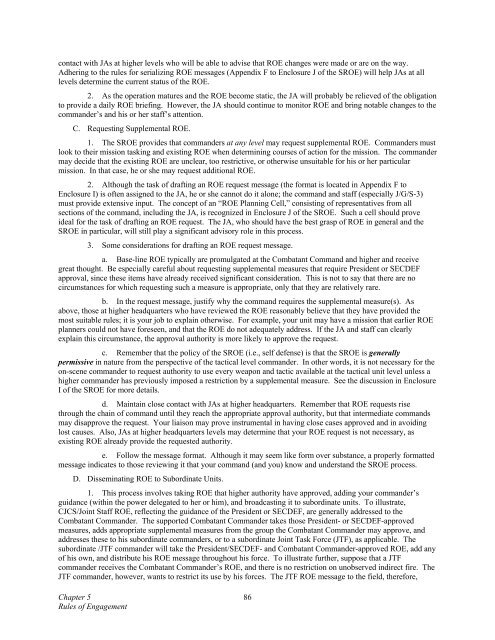The Law of War
The Law of War
The Law of War
Create successful ePaper yourself
Turn your PDF publications into a flip-book with our unique Google optimized e-Paper software.
contact with JAs at higher levels who will be able to advise that ROE changes were made or are on the way.<br />
Adhering to the rules for serializing ROE messages (Appendix F to Enclosure J <strong>of</strong> the SROE) will help JAs at all<br />
levels determine the current status <strong>of</strong> the ROE.<br />
2. As the operation matures and the ROE become static, the JA will probably be relieved <strong>of</strong> the obligation<br />
to provide a daily ROE briefing. However, the JA should continue to monitor ROE and bring notable changes to the<br />
commander’s and his or her staff’s attention.<br />
C. Requesting Supplemental ROE.<br />
1. <strong>The</strong> SROE provides that commanders at any level may request supplemental ROE. Commanders must<br />
look to their mission tasking and existing ROE when determining courses <strong>of</strong> action for the mission. <strong>The</strong> commander<br />
may decide that the existing ROE are unclear, too restrictive, or otherwise unsuitable for his or her particular<br />
mission. In that case, he or she may request additional ROE.<br />
2. Although the task <strong>of</strong> drafting an ROE request message (the format is located in Appendix F to<br />
Enclosure I) is <strong>of</strong>ten assigned to the JA, he or she cannot do it alone; the command and staff (especially J/G/S-3)<br />
must provide extensive input. <strong>The</strong> concept <strong>of</strong> an “ROE Planning Cell,” consisting <strong>of</strong> representatives from all<br />
sections <strong>of</strong> the command, including the JA, is recognized in Enclosure J <strong>of</strong> the SROE. Such a cell should prove<br />
ideal for the task <strong>of</strong> drafting an ROE request. <strong>The</strong> JA, who should have the best grasp <strong>of</strong> ROE in general and the<br />
SROE in particular, will still play a significant advisory role in this process.<br />
3. Some considerations for drafting an ROE request message.<br />
a. Base-line ROE typically are promulgated at the Combatant Command and higher and receive<br />
great thought. Be especially careful about requesting supplemental measures that require President or SECDEF<br />
approval, since these items have already received significant consideration. This is not to say that there are no<br />
circumstances for which requesting such a measure is appropriate, only that they are relatively rare.<br />
b. In the request message, justify why the command requires the supplemental measure(s). As<br />
above, those at higher headquarters who have reviewed the ROE reasonably believe that they have provided the<br />
most suitable rules; it is your job to explain otherwise. For example, your unit may have a mission that earlier ROE<br />
planners could not have foreseen, and that the ROE do not adequately address. If the JA and staff can clearly<br />
explain this circumstance, the approval authority is more likely to approve the request.<br />
c. Remember that the policy <strong>of</strong> the SROE (i.e., self defense) is that the SROE is generally<br />
permissive in nature from the perspective <strong>of</strong> the tactical level commander. In other words, it is not necessary for the<br />
on-scene commander to request authority to use every weapon and tactic available at the tactical unit level unless a<br />
higher commander has previously imposed a restriction by a supplemental measure. See the discussion in Enclosure<br />
I <strong>of</strong> the SROE for more details.<br />
d. Maintain close contact with JAs at higher headquarters. Remember that ROE requests rise<br />
through the chain <strong>of</strong> command until they reach the appropriate approval authority, but that intermediate commands<br />
may disapprove the request. Your liaison may prove instrumental in having close cases approved and in avoiding<br />
lost causes. Also, JAs at higher headquarters levels may determine that your ROE request is not necessary, as<br />
existing ROE already provide the requested authority.<br />
e. Follow the message format. Although it may seem like form over substance, a properly formatted<br />
message indicates to those reviewing it that your command (and you) know and understand the SROE process.<br />
D. Disseminating ROE to Subordinate Units.<br />
1. This process involves taking ROE that higher authority have approved, adding your commander’s<br />
guidance (within the power delegated to her or him), and broadcasting it to subordinate units. To illustrate,<br />
CJCS/Joint Staff ROE, reflecting the guidance <strong>of</strong> the President or SECDEF, are generally addressed to the<br />
Combatant Commander. <strong>The</strong> supported Combatant Commander takes those President- or SECDEF-approved<br />
measures, adds appropriate supplemental measures from the group the Combatant Commander may approve, and<br />
addresses these to his subordinate commanders, or to a subordinate Joint Task Force (JTF), as applicable. <strong>The</strong><br />
subordinate /JTF commander will take the President/SECDEF- and Combatant Commander-approved ROE, add any<br />
<strong>of</strong> his own, and distribute his ROE message throughout his force. To illustrate further, suppose that a JTF<br />
commander receives the Combatant Commander’s ROE, and there is no restriction on unobserved indirect fire. <strong>The</strong><br />
JTF commander, however, wants to restrict its use by his forces. <strong>The</strong> JTF ROE message to the field, therefore,<br />
Chapter 5 86<br />
Rules <strong>of</strong> Engagement

















